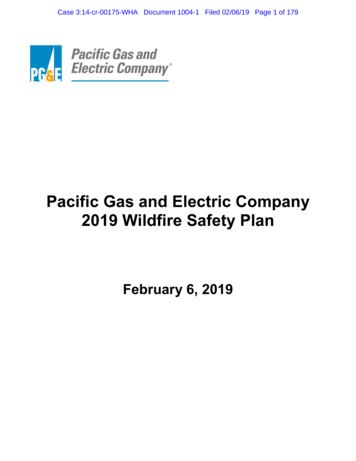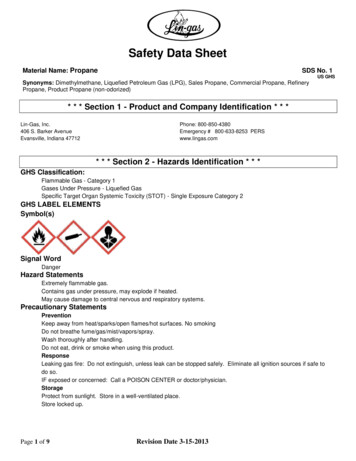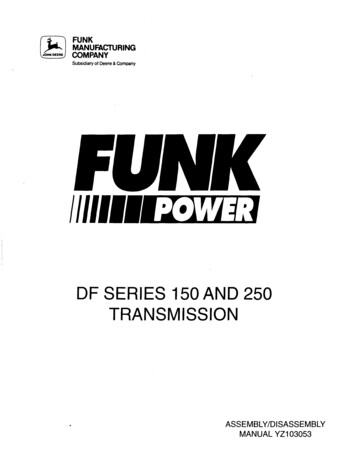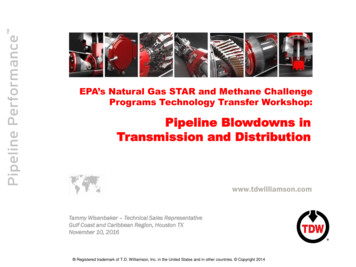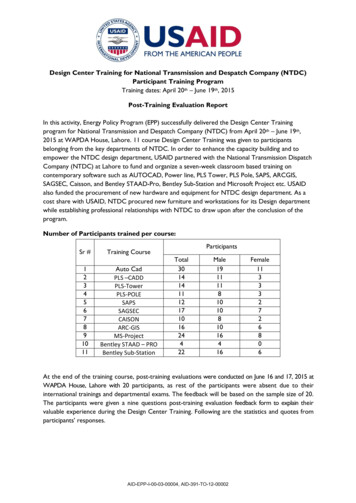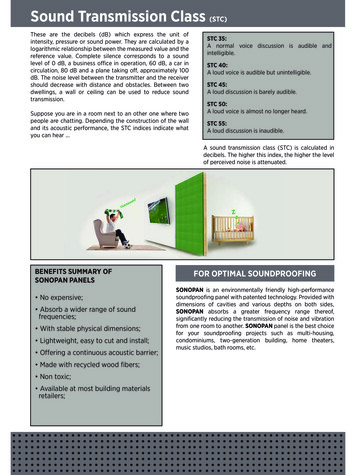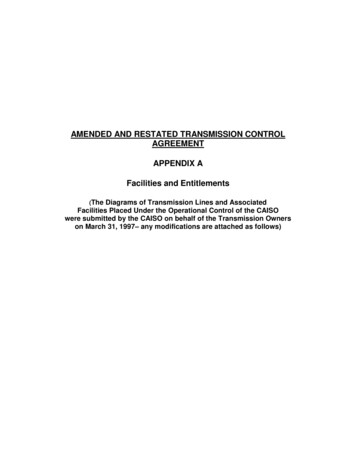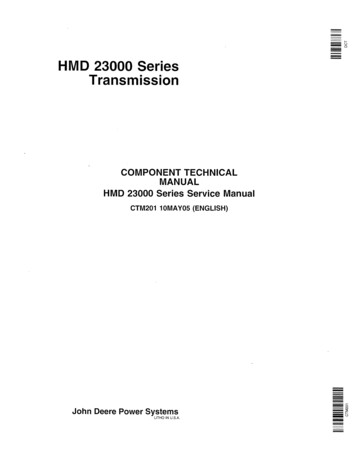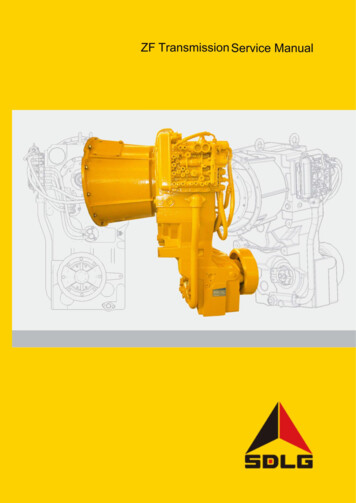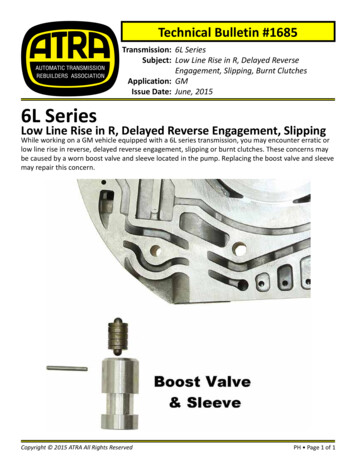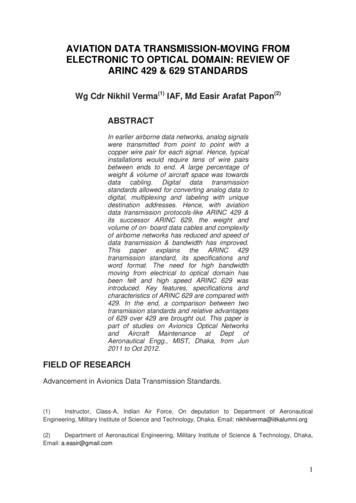
Transcription
Safety of Gas Transmissionand Gathering PipelinesRIN: 2137-AE72Docket: PHMSA - 2011 – 0023Gas Pipeline Advisory Committee MeetingDecember 14 - 15, 20171
Recap of 1/11 & 1/12/2017 MeetingsTopicResult6-month Grace Period for 7 calendar yearReassessment Intervals § 192.939(b)Safety Features on ILI Launchers/Receivers§ 192.750Seismicity § 192.917Inspections Following Extreme Events§ 192.613Management of Change § 192.911Corrosion ControlRecordsIM Clarifications2Vote: PassedDiscussedand Deferredto June 2017Mtg. (Slide 3)
Recap of 6/6 & 6/7/2017 MeetingsTopicResultCorrosion Control; §§ 192.319, 192.461, 192.465,192.473, 192.478, 192.935(f) & (g), Appendix DRecords; §§ 192.5(d), 192.227(c), 192.285(e),192.619(f), 192.624(f)IM Clarifications; §§ 192.917(a), (b), (c), (d), &(e)(2), 192.935(a)Vote: PassedMAOP Exceedances; §§ 191.1, 191.23, 191.25, 191.29Records; §§ 192.13(e), 192.67, 192.127,192.205IM Clarifications; §§ 192.917 (e)(3) & (e)(4)Material Documentation; § 192.6073Discussed:VotePostponed
Agenda for December 14 – 15, 2017Meetings1. Material Documentation – 192.6072. Integrity Verification Process (IVP) 192.624; 192.619(e); 192.5034
Agenda for December 14 – 15, 2017Meetings(If time allows)3. Strengthened Assessment Requirementsa. 192.493 – Industry standards for ILIb. 192.921(a) – Expand assessment methods allowed for IMc. 192.923(b) & 192.927 - ICDAd. 192.923(c) & 192.929 - SCCDAe. App. F – Guided Wave Ultrasonics (GWUT)f. 192.150 – Passage of Internal Inspection Devices5
Remaining Agenda Items for Future Meetings(Schedule TBD) Votes on topics tabled from Meeting #2 (Records,IM Clarifications) and discussed in Meeting #3(Material Documentation) Topics not covered or completed from thismeeting Assessments Outside of HCAs, Repair Criteria Gathering Lines– Reporting (Part 191)– Safety 192.8; 192.9; other conforming changes6
Material Documentation:Proposed 192.6077
Material Documentation192.607The Issue of Missing Records Immediately after the San Bruno, CA accident, NTSBissued 3 urgent recommendations to PG&E. NTSBrecommended that PG&E:– Conduct an immediate search for missing records– Use verifiable records to determine a valid MAOP, and– If a valid MAOP cannot be substantiated, conduct pressuretests to re-establish a valid MAOP The results of the PG&E review revealed that PG&E couldnot substantiate MAOP for a significant amount ofPG&E’s transmission system8
Material Documentation192.607Implications to Industry In the wake of the San Bruno incident and PG&E problemsrevealed by the records review, Congress mandated (2011Act, Section 23) that:– All pipeline operators conduct a records review for segmentsin HCAs and Class 3 and 4 locations, and report the results toPHMSA– “The purpose of the verification shall be to ensure that therecords accurately reflect the physical and operationalcharacteristics of the pipelines and confirm the establishedmaximum allowable operating pressure of the pipelines”9
Material Documentation192.607Implications to Industry To establish design and maximumoperating pressures (MAOP) For integrity management (IM) Anomaly evaluations forsafe operating pressure10
Material Documentation192.607Implications to Industry In 2016, operators reported 4,500 miles of pipe in HCAsand Class 3 & 4 locations had inadequate records toconfirm MAOP (11% of 40,000 miles)LocationMiles withIncomplete RecordsTotal HCA Class 3 & 4 (Miles)HCAs2,144 (11%)20,374Class 3 (non-HCA)2,372 (12%)19,648Class 4 (non-HCA)19 (9%)2024,535 (11%)40,224Total11
Incomplete Records192.619(c) Grandfathered Pipe2016 Operator Annual Report DataLocationGrandfathered Miles w/Incomplete RecordsTotalGrandfathered(Miles)19 (22%)87[data not collected]37,76415 (28%)54[data not collected]2,592Class 3 (HCA)475 (31%)1,512Class 3 (non-HCA)607 (30%)2,0415 (45%)1118 (95%)191,139 (2.5%)(Total addressed per 2011 Act §23)44,080Class 1 (HCA)Class 1 (non-HCA)Class 2 (HCA)Class 2 (non-HCA)Class 4 (HCA)Class 4 (non-HCA)Total12
Material Documentation192.607Implications to Industry For segments without such records, Congress alsomandated (2011 Act, Section 23) that PHMSA– Require the operator to reconfirm a maximum allowableoperating pressure as expeditiously as economically feasible;and– Determine what actions are appropriate for the pipelineowner or operator to take to maintain safety until amaximum allowable operating pressure is confirmed.13
Material Documentation192.607Implications to Industry In addition, Congress (as well as NTSB in its report on the SanBruno accident) included other mandates and recommendationsthat have significant implications to the issue of missing records tosubstantiate MAOP PSA of 2011 - § 23(a) 60139(d) mandate “TestingRegulations” - pressure testing or alternative equivalent meanssuch as ILI program for all Gas Transmission pipe (Class 3, 4 and allHCAs) not previously tested; NTSB P-11-14 “Delete Grandfather Clause” recommends all grandfathered pipe be pressure tested,including a “spike” test for HCA and non-HCA segments NTSB P-11-15 “Seam Stability” - recommends pressure test to1.25 x MAOP before treating latent manufacturing and constructiondefects as “stable” for all pipe, both HCA and non-HCA segments14
Material Documentation192.607Alternatives PHMSA Considered A “no action” alternative is not feasible– Congress has mandated action that is now law– Actions required by existing regulations (49 CFR192.107) to establish material properties for unknownpipe segments would be prohibitively expensive. Alternatively, operators would have to assume alower pipe yield strength of 24,000 psi.15
Material Documentation 192.607Alternatives PHMSA Considered (cont.)– Cutting out pipe samples for testing is prohibitivelyexpensive– Simply pressure testing the pipe does not addressmissing records needed for reasons other thanestablishing MAOP, such as integrity evaluations Information needed for analyzing/prioritizing defectsfor repair, etc.– All pipe segments (HCA and non-HCA) are currentlysubject to repair requirements, which require materialproperties to be known.16
Material Documentation192.607Proposed Rule to Re-establish Material Properties PHMSA proposed a process that is based on an opportunisticsampling approach– No mandatory excavation solely for verification of pipematerial properties would be required– Verify material properties as opportunities present themselvesduring the course of normal operations and maintenance,such as excavations for evaluation or repair of anomalies or defects– Allow non-destructive testing to verify material properties wherefeasible– Operator could elect destructive testing per existing code (e.g., if thesegment is being replaced anyway)– Components such as valves, flanges, and fabrications could be verifiedby code stamp and other markings1717
Material Documentation192.607Proposed Rule to Re-establish Material Properties(cont.) PHMSA proposed a process that is based on anopportunistic sampling approach:– Over time operators will gain data and records toprovide confidence in material properties (PHMSA didnot propose a schedule or deadline for completion)– Use the results to extrapolate to other unknownsegments– Discontinue the program after a specified number ofsegment properties had been verified1818
Material Documentation192.607 (2004-2016 Operator Annual Report Data)Industry RepairsHCA Repairs13 Yr. TotalsHCA Repairs/Yr(Average)2016 HCA(Miles)10,486807/yr. (all operators)20,3741,441 (14%)55/yr/operator438 (2%)Top 15 operators by HCAMileage3,485 (34%)18/yr/operator9,162 (45%)Top 15 operators by HCArepairs5,293 (51%)27/yr/operator4,184 (20%)Operators with fewrepairs (178 operators)5,033 (49%)2/yr/operator14,368 (70%)Total HCA Repairs(2004-2016)Top 2 operators withHCA repairs2016 Annual Report data indicates 1,034 gas transmission operators with OpIDs.Prior to 2010, HCA miles and repairs were reported per ASME B31.8s GT IMinformation collection. As of 2010, this data is included in GT Annual Reports.19
Material Documentation192.607Minimum Required Parameters PHMSA considered the minimum material properties thatmust be known to establish MAOP, and to operate andmaintain the pipeline to assure operating pressure stayswithin the MAOP limits Pipe segments for which 192.607 does not apply wouldcontinue to be subject to existing rule requirements toestablish unknown material properties20
Material Documentation192.607Minimum Required Parameters (cont.) The minimum material properties are:– Diameter, wall thickness, yield strength, & tensile strength Design Pressure (192.105), MAOP determination (192.619(a)) Safe operating pressure of pipe with defects (192.933)– Ultimate tensile strength (See API 5L requirements, whichrequires reporting of UTS) Required by ASME B31G equations (IBR- approved for§§192.485(c) and 192.933(a)) for calculating failure pressure andsafe operating pressure. Material loss equations for safe pressure determination requireyield strength and flow stresses that are below the tensile strength.21
Material Documentation192.607API 5L Specification (IBR Part 192)22
Material Documentation192.607Minimum Required Parameters (cont.)– Charpy v-notch toughness (only where required forfailure pressure and crack growth analysis)– Chemical properties (welding per Subpart E)– Seam type (IMP threat analysis per 192.917, pressuretesting requirements per proposed 192.624) [Note: thiswas a key piece of erroneous information thatcontributed to San Bruno accident.]– Coating type (IMP threat analysis per 192.917)– Test for the presence of stress corrosion cracking, seamcracking, or selective seam weld corrosion23
Material Documentation192.607API 5L Specification (IBR Part 192)24
Pipe Properties TestExample Non-destructive Test ResultsYield Strength andTensile Strength – TestsGrade: X-70Pipe ChemistryField Test Results25
Material Documentation192.607Other Issues PHMSA proposed to require operators establish samplepopulations based on similar or comparable pipe to address:– Vintage– Manufacturer– Type of Seam– Pipelines acquired from others– Segments of pipeline systems that have been replaced– Other reasons for variation in unknown pipe properties26
Material Documentation192.607 Committee Comments:– Clarify that two separate activities drive the need formaterial documentation, which should be addressedseparately MAOP Reconfirmation for pipelines that do nothave traceable, verifiable, and complete recordssupporting the current MAOP, including previouslyuntested pipe– Address data needed in 192.624 Application of Integrity Management principles– Material data/records needed to support anomalyresponse and remediation calculations27
Material Documentation192.607 Committee Comments:– Committee was supportive of the opportunisticapproach for verifying material properties– Industry commented to allow a statisticalsampling plan developed by operators insteadof specifying number of samples28
Material Documentation192.607 Based on committee discussion, PHMSAsuggests the committee consider:– Revise proposed 192.607(a) to delete all applicabilitystatements– 192.607 would be silent on when material verification isneeded it would simply provide the procedure for doingso, if and when required by 192.624 or other code sections– Allow the procedure in 192.607 to be used wheneverrequired or allowed by other sections in Part 192 toaddress applicable missing records “(a) Wherever required or allowed by this Part, operators must verifyunknown material properties in accordance with this section.”29
Material Documentation192.607 Based on committee discussion, PHMSA suggests thecommittee consider:– Revise proposed 192.607(c) to delete the minimum list of requiredattributes– 192.607(c) would be silent on the specific attributes that need to beverified it would simply specify that operators must keep records forthe attributes documented under 607(c).– Allow operators to use 192.607 to reverify any pipeline attributes asapplicable, based on the specific driver or purpose needed, as requiredin other sections of Part 192. (c) “Each operator must have and retain for the life of the pipelinetraceable, verifiable, and complete records documenting all pipeproperties (such as diameter, wall thickness, grade, yield strength,ultimate tensile strength, seam type, or pressure rating, etc.),established under this section.”30
Material Documentation192.607 Based on committee discussion, PHMSA suggests thecommittee consider:– In the context of considering the proposed changes to paragraphs (a)and (c), consider retaining the procedure specified in paragraph (d). Allowing each operator to establish its own undefined statisticalbasis would be too much discretion without assurance that aminimum standard was being met. Retain opportunistic approach of obtaining material propertieswhen excavations are performed for other repairs or other reasons,using a one-per-mile standard proposed by PHMSA. Retain flexibility to use either non-destructive or destructivemethods for property verification. If operators desire to use their own statistical approach, they maysubmit a notification under 192.607(d)(6). Reduce the notification timeframe from 180 days to 90 days toassure more timely review by PHMSA for objection/no objection.31
Material Documentation192.607Public Comments32
Material Documentation192.607GPAC Discussion33
IVP Introduction34
Integrity Verification Program (IVP)192.619; 192.624; 192.506– Statutory Mandates and NTSB Rec.– Material Documentation– MAOP Determination3521
Congressional MandatesPipeline Safety Act of 2011 PSA §23(a) 60139(a) & (b) – Verification ofRecords and Reporting –– Requires operators to identify pipe segments for which theydo not have records to substantiate MAOP for all GasTransmission steel pipe (Class 3, 4 and all HCAs);– Exceedance
Prior to 2010, HCA miles and repairs were reported per ASME B31.8s GT IM information collection. As of 2010, this data is included in GT Annual Reports. 20. Material Documentation. 192.607 Minimum Required Parameters PHMSA considered the minimum material properties that must be known to establish MAOP, and to operate and maintain the pipeline to assure operating pressure stays within

